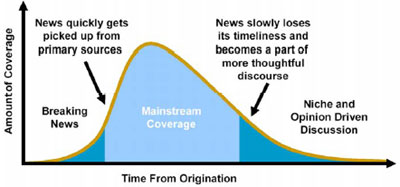The Long Tail (2)


Of ze zich hebben laten inspireren door het artikel van Chris Anderson weet ik niet, maar Mary Meeker, Brian Pitz en Brian Fitzgerald (allen Morgan Stanley), hebben een interessante studie gedaan naar de mogelijke effecten van weblogs, RSS en contentsyndicatie op nieuwsverspreiding (pdf).
Een absolute aanrader om te lezen!
In dit kader is het leuk om te melden dat plm 7 weken na de start van podcasting er nu een groot artikel in de NY Times staat. Het lijkt alsof ook de “time to break” van weblogs naar mainstream steeds sneller gaat. Een nog steiler lijntje in de grafiek wellicht?
Ben het met je eens dat de “time-to-break” steeds korter wordt. 7 weken vind ik dan eigenlijk nog niet eens bijzonder snel.